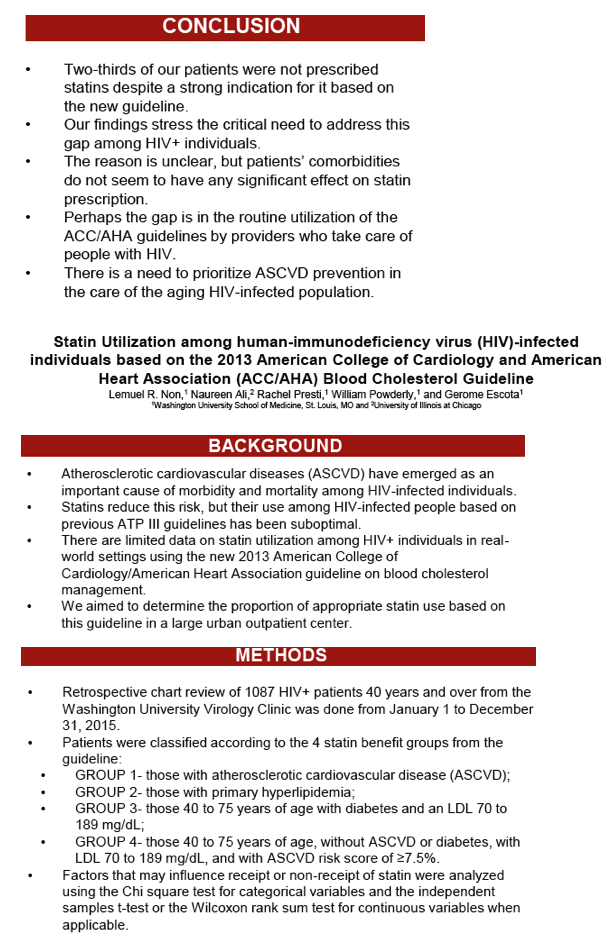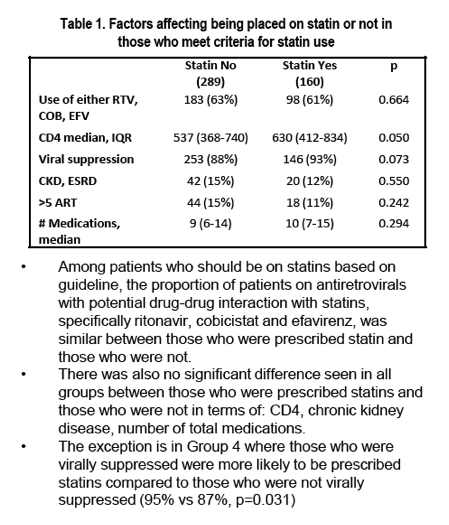 |
 |
 |
| |
Two Thirds of HIV Group Who Need Statins Not Getting Them
|
| |
| |
IDWeek2017/IDSA, October 4-8, 2017, San Diego
Mark Mascolini
Two thirds of HIV-positive people in a St. Louis clinic with a statin indication by 2013 ACC/AHA guidelines did not have a statin prescription [1]. People with a higher CD4 count were significantly more likely to get a statin.
Although statins reduce risk of atherosclerotic cardiovascular disease (ASCVD), their uptake proved suboptimal in HIV patients when compared with earlier ATP III guidelines. Researchers at Washington University, St. Louis, conducted this study to gauge statin use according to 2013 guidelines from the American College of Cardiology/American Heart Association [2].
This retrospective chart review involved 1085 HIV-positive people 40 or older seen from January through December 2015 at the Washington University Virology Clinic. The researchers categorized participants into one of four statin benefit groups:
1. Clinical ASCVD
2. Primary hyperlipidemia: low-density lipoprotein (LDL) cholesterol at or above 190 mg/dL
3. 40 to 75 years old with diabetes and LDL 70 to 189 mg/dL without ASCVD
4. 40 to 75 years old without ASCVD or diabetes, with LDL 70 to 189 mg/dL, and 10-year ASCVD risk of at or above 7.5%
Study participants averaged 51.9 years in age, 68% were black, 31% white, and 71% men. Nearly half of these people, 45%, smoked. Almost everyone, 98%, was taking antiretroviral therapy, and 86% had an undetectable viral load. Most people, 56%, had hypertension, while 16% had diabetes, 9% chronic kidney disease, and 5% coronary artery disease.
Among 449 people with a statin indication by 2013 ACC/AHA guidelines, 289 (64%) took no statin. Among 121 people in risk group 1, 78 (64%) did not take a statin. Proportions not taking a statin were 5 of 9 (56%) in group 2, 55 of 107 (51%) in group 3, and 151 of 213 (71%) in group 4. In three of the four groups, most participants were taking low-dose statins: 56% in group 1, 63% in group 3, and 64% in group 4. One quarter of group 2 members took low-dose statins.
Two clinical factors favored statin use: higher CD4 count (median 630 in the statin group versus 537 in the no-statin group, P = 0.050) and viral suppression (93% versus 88%, P = 0.073). Factors that did not affect statin use in this analysis were chronic kidney disease or end-stage renal disease, taking more than 5 antiretrovirals, median number of all medications, and use of antiretrovirals that may interact with statins--ritonavir, cobicistat, or efavirenz.
The researchers see "a critical need" to close the gap between statin recommendations and prescriptions. They speculated that too few HIV providers use the ACC/AHA guidelines.
References
1. Non LR, Ali N, Presti R, Powderly W, Escota G. Statin utilization among HIV-infected individuals based on the 2013 ACC/AHA blood cholesterol guideline. IDWeek2017/IDSA. October 4-8, 2017. San Diego. Abstract 574.
2. Stone NJ, Robinson J, Lichtenstein AH, et al. 2013 ACC/AHA guideline on the treatment of blood cholesterol to reduce atherosclerotic cardiovascular risk in adults. A report of the American College of Cardiology/American Heart Association Task Force on Practice Guidelines. Circulation. 2015;132:e396. http://circ.ahajournals.org/content/early/2013/11/11/01.cir.0000437738.63853.7a



|
| |
|
 |
 |
|
|